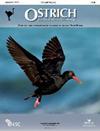Diversity and abundance of avifauna in the Suba Forest area, central Ethiopia
IF 1.1
4区 生物学
Q2 ORNITHOLOGY
引用次数: 0
Abstract
AbstractBirds are one of the best-described taxa, but detailed knowledge about most bird species in Ethiopia remains rare, which hinders the development and evaluation of conservation strategies in the region. In this study, we estimated bird species diversity and abundance in the Suba Forest area (comprising natural forest and adjacent plantation forest and farmland) in central Ethiopia, during the dry and wet seasons in 2021. Bird data were collected using line transects or point counts in each habitat type. Two-way ANOVA was applied to evaluate the effect of habitat and season on bird species richness and abundance. A total of 132 bird species belonging to 51 families were recorded during the study. Of these, 124 are residents, 4 are endemic to Ethiopia, 11 are endemic to Ethiopia and Eritrea, and 4 are near endemics (one largely confined to Ethiopia and the others with their core populations in Ethiopia and Eritrea). Habitat type and season both had significant effects on species abundance and richness. Species diversity was highest in natural forest during the wet season, and lowest in farmland during the dry season. Plantation forest and farmland shared similar avian communities, with both being human-altered habitats in close proximity to each other. Native forest supported the highest number of bird species, which confirms the Suba Forest area’s great potential for biodiversity conservation and sustainable wildlife tourism. Continuous monitoring of this area and effective implementation of conservation measures will provide beneficial outcomes for not only avifauna but other taxa.Diversité et abondance des oiseaux de la forêt de Suba, Éthiopie centraleLes oiseaux sont un des groupes les mieux décrits de la biodiversité terrestre, mais les connaissances détaillées sur la plupart des espèces d’oiseaux en Éthiopie restent rares, ce qui entrave le développement et l’évaluation des stratégies de conservation dans la région. Dans cette étude, nous avons estimé la diversité et l’abondance des espèces d’oiseaux dans la forêt naturelle, la forêt de plantation et les terres agricoles de la forêt de Suba, en Éthiopie centrale, pendant la saison sèche et et la saison des pluies de 2021. Les données sur les oiseaux ont été collectées à l’aide de transects linéaires ou de points de comptage dans les trois habitats. Une ANOVA à deux facteurs a été utilisée pour évaluer l’effet de l’habitat et de la saison sur la richesse et l’abondance des espèces. Au total, 132 espèces d’oiseaux appartenant à 51 familles ont été identifiées au cours de la période d’étude. Parmi elles, 124 étaient résidentes, 4 étaient endémiques à l’Éthiopie, 11 étaient endémiques à l’Éthiopie et à l’Érythrée, et 4 étaient des ‘presque-endémiques’ (une presque entièrement confiné à l’Éthiopie, et les autres avec la plus grande partie de leurs populations entre l’Éthiopie et l’Érythrée). Le type d’habitat et la saison ont eu des effets significatifs sur l’abondance et la richesse des espèces: la diversité des espèces étant la plus élevée dans les forêts naturelles pendant la saison humide, et la plus faible sur les terres agricoles pendant la saison sèche. Les habitats des forêts de plantation et des terres agricoles partagent des communautés d’oiseaux similaires, étant tous les deux des habitats modifiés par l’homme et situés à proximité l’un de l’autre. La plus grande diversité d’oiseaux enregistrée dans la forêt naturelle confirme le grand potentiel de la région pour la conservation de la biodiversité et pour le développement du tourisme de nature durable. La surveillance continue de la zone d’étude et la mise en oeuvre efficace de mesures de conservation auront des effets bénéfiques non seulement sur l’avifaune, mais aussi sur d’autres taxons de la région.Keywords: avitourismconservationecotourismencounter rateendemic speciesland-use matrixmonitoringnatural forest埃塞俄比亚中部苏巴森林地区鸟类的多样性和丰富性
摘要鸟类是被描述最完整的分类群之一,但对埃塞俄比亚大多数鸟类的详细了解仍然很少,这阻碍了该地区鸟类保护策略的发展和评估。在这项研究中,我们估计了埃塞俄比亚中部Suba森林地区(包括天然林和邻近的人工林和农田)在2021年旱季和雨季的鸟类多样性和丰度。鸟类资料采用样线法或点计数法收集。采用双因素方差分析分析了生境和季节对鸟类物种丰富度和丰度的影响。研究共记录鸟类51科132种。其中124种为居民病,4种为埃塞俄比亚地方病,11种为埃塞俄比亚和厄立特里亚地方病,4种接近地方病(一种主要局限于埃塞俄比亚,其他主要人群在埃塞俄比亚和厄立特里亚)。生境类型和季节对物种丰度和丰富度均有显著影响。物种多样性在旱季以天然林最高,旱季以农田最低。人工林和农田有着相似的鸟类群落,两者都是人类改变的栖息地,彼此靠近。原生森林支持的鸟类数量最多,这证实了苏巴森林地区在生物多样性保护和可持续野生动物旅游方面的巨大潜力。对该地区的持续监测和有效实施保护措施将为鸟类和其他分类群提供有益的结果。多样性和丰富度- - - - - - - - - - - - - - - - - - - - - - - - - - - - - - - - - - - - - - - - - - - - - - - - - - - - - - - - - - - - - - - - - - - - - - - - - - - - - - - - - - - - - - - - - - - - - - - - - - - - - - -Dans cette , nous avons estim la diversit et l ' aboundes des diversit et l ' aboundes des diverseise de forêt naturelle, la forêt de plantation et les terres agricoles de la forêt de Suba, en Éthiopie centrale, pendant la saison satisque et et la saison des pluies de 2021。在三个不同的生境中,有三个不同的生境,即三个不同的生境和三个不同的生境。单因素方差分析(ANOVA)对两个因素进行了分析,分别是:1、生活的影响、生活的富裕程度、生活的富足程度。总共有132个例外情况,51个例外情况,确定了所有例外情况。帕尔米耶尔,124个被列为 职业健康健康组织成员的人,4个被列为 职业健康健康组织成员的人,11个被列为 与 职业健康组织成员的人,4个被列为前职业健康组织成员的人(1个被列为前职业健康组织成员的人,1个被列为前职业健康组织成员的人,1个被列为前职业健康组织成员的人,1个被列为前职业健康组织成员,1个被列为前职业健康组织成员,1个被列为前职业健康组织成员,1个被列为前职业健康组织成员,1个被列为前职业健康组织成员,1个被列为前职业健康组织成员,1个被列为前职业健康组织成员,1个被列为前职业健康组织成员,1个被列为前职业健康组织成员,1个被列为前职业健康组织成员。生境类型和气候变化对气候变化的影响显著:气候变化的多样性和气候变化的丰富性;气候变化的多样性和气候变化的多样性;气候变化的多样性和气候变化的多样性;气候变化的多样性;气候变化的多样性;气候变化的多样性;气候变化的多样性;气候变化的多样性;气候变化的多样性;气候变化的多样性;气候变化的多样性;气候变化的多样性。种植业生境与农业土地生境的交换交换交换交换交换交换交换交换交换交换交换交换交换交换交换交换交换交换交换交换交换交换交换交换交换交换交换。在自然资源管理和生物多样性登记方面,我们确认了自然资源管理和生物多样性保护方面的巨大潜力,以及在自然资源管理和旅游业发展方面的巨大潜力。监测将继续进行,监测将继续进行,监测将继续进行,监测将继续进行,监测将继续进行,监测将继续进行,监测将继续进行,监测将继续进行,保护将继续进行,监测将继续进行,监测将继续进行,监测将继续进行,监测将继续进行,监测将继续进行,保护将继续进行,监测将继续进行,监测将继续进行,监测将继续进行,监测将继续进行,监测将继续进行,监测将继续进行,监测将继续进行,监测将继续进行。关键词:旅游保护;生态旅游;特有物种
本文章由计算机程序翻译,如有差异,请以英文原文为准。
求助全文
约1分钟内获得全文
求助全文
来源期刊

Ostrich
生物-鸟类学
CiteScore
2.10
自引率
30.00%
发文量
24
审稿时长
>12 weeks
期刊介绍:
Ostrich: Journal of African Ornithology is the leading ornithological journal in Africa, and publishes peer-reviewed scientific papers and short communications (
 求助内容:
求助内容: 应助结果提醒方式:
应助结果提醒方式:


